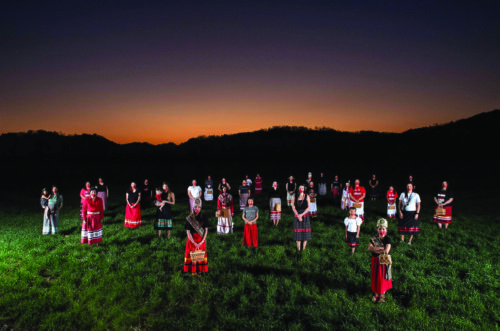By Brooklyn Brown
Tsisqwohi (Birdtown)
When I started working at the Cherokee One Feather in October 2023, an immediate goal of mine was to create recurring graphics and articles on the MMIW (Missing and Murdered Indigenous Women) movement, specifically as it relates to the Qualla Boundary.
I first learned about the MMIW movement as a student at UNC Chapel Hill. Faith Danielle Hedgepeth, a 19-year-old UNC student, was brutally murdered in 2012 in her off-campus apartment. In 2016, I became a freshman at UNC, and quickly joined the Carolina Indian Circle (CIC), the Native American student group on campus. During my sophomore year, I also joined the oldest and largest Native American sorority, Alpha Pi Omega Sorority, Inc. I learned that Faith was my sorority sister, and she was also a part of CIC. We walked the same paths at UNC. She, like me and so many other Indigenous women, was a young person just trying to find community and make it at Carolina. She lost her life to a senseless act of violence, and now CIC and Alpha Pi Omega hold vigils in her remembrance.

Cherokee women and girls stand in the fields of Kituwah just before dusk for MMIW. (Photo courtesy of Ashley Evans, WCU Senior Photographer)
After I graduated from UNC, I attended Western Carolina University (WCU) and received a Master of Arts in History on the Cherokee Studies track. At the time, Sky Sampson was the director of the WCU Cherokee Center. Sky, who continues to be a mentor and inspiration to me in her new role as the EBCI Secretary of Community, Education, and Recreation, was a strong advocate for MMIW awareness at WCU. She helped implement an MMIW exhibit at the Bardo Arts Center on campus, which featured photographs and art from the MMIW photoshoot she orchestrated at Kituwah.
That MMIW photoshoot was incredibly powerful. Anyone who was a part of that photoshoot, from photographers Dylan Rose and Ashley Evans to the 40+ people who participated, can testify as to how powerful that experience was. We met at Kituwah in the evening, right before dusk. The sun set into the mountains while we stood in the fields. We wore red paint on our faces, red ribbon skirts and shirts. There were Cherokee women and girls—generations of Cherokee women who knew what it meant that we were still standing there, amongst the graves of the women who had stood there before us.
It was after that photoshoot that the Qualla Boundary MMIW NC Chapter Coalition was formed by the leadership of Cherokee elder Loretta Bolden and continues with the leadership of Elvia Walkingstick and Atsei Cooper. Cherokee also boasts a MMIW podcast, “We Are Resilient,” created by Ahli-sha Stephens, Maggie Jackson and Sheyahshe Littledave. We are lucky to have a solid MMIW movement community in Cherokee.
With that said, I’ve seen some bizarre arguments taking place online surrounding MMIW. There is a push right now on a national level for Missing and Murdered Indigenous People (MMIP) or Missing and Murdered Indigenous Relatives (MMIR). I agree with highlighting MMIP/MMIR. Indigenous lives matter, no matter the gender. Still, Indigenous women and girls experience violence and murder at a disproportionate rate. Is it a…competition? It seems to be portrayed that way currently. There are also “competitions” being waged between missing and murdered Indigenous people in general, which is the grossest thing I’ve seen.
Violence against Indigenous people is not gender specific, but it is gender disproportionate. Violence against Native men is violence against Native women. Violence against Native women is violence Native men. Violence against Native people is violence against Native people. While we discuss semantics, our people are being killed. The goal of the movement is not attention, it is awareness. Awareness for all Indigenous communities. My goal, in my corner of the woods, is to bring awareness for our community, as is the goal, I’m sure, of the MMIW movement here on the Qualla Boundary. Join us.





